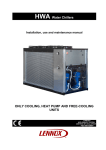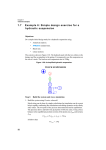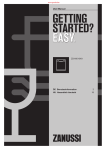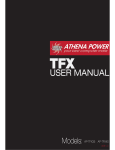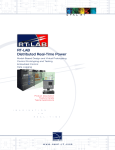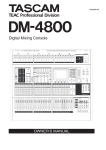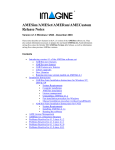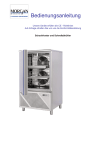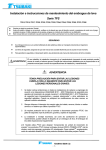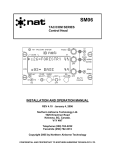Download Thermal-Hydraulic Component Design Library
Transcript
Thermal-Hydraulic Component Design Library Version 4.2 – September 2004 ® Copyright IMAGINE S.A. 1995-2004 AMESim® is the registered trademark of IMAGINE S.A. AMESet® is the registered trademark of IMAGINE S.A. ADAMS is a registered United States trademark of Mechanical Dynamics, Incorporated. ADAMS/Solver and ADAMS/View are trademarks of Mechanical Dynamics, Incorporated. MATLAB and SIMULINK are registered trademarks of the Math Works, Inc. Netscape and Netscape Navigator are registered trademarks of Netscape Communications Corporation in the United States and other countries. Netscape’s logos and Netscape product and service names are also trademarks of Netscape Communications Corporation, which may be registered in other countries. PostScript is a trademark of Adobe Systems Inc. UNIX is a registered trademark in the United States and other countries exclusively licensed by X / Open Company Ltd. Windows, Windows NT, Windows 2000 and Windows XP are registered trademarks of the Microsoft Corporation. X windows is a trademark of the Massachusetts Institute of Technology. All other product names are trademarks or registered trademarks of their respective companies. TABLE OF CONTENTS 1. Introduction..............................................................................................................1 2. Getting started with the Thermal-Hydraulic Component Design Library.........2 3. A new Thermal-Hydraulic properties submodel...................................................9 4. Another application example: high-pressure fuel injector.................................13 5. Formulation of equations and underlying assumptions .....................................22 5.1. PISTON SUBMODELS ..........................................................................................23 5.2. RESISTIVE COMPONENTS ..................................................................................23 5.3. CAPACITIVE COMPONENTS ...............................................................................24 5.4. FURTHER ASSUMPTIONS ...................................................................................26 5.5. OTHER IMPORTANT RULES ................................................................................26 References...................................................................................................................28 September 2004 Table of Contents 1/1 Using the Thermal-Hydraulic Component Design Library 1. Introduction The Thermal-Hydraulic Component Design Library (THCD) is used to construct a model of a component from a collection of very basic blocks. This methodology is very efficient because it enables you to go very deeply into the details of the components technology. For instance, all types of hydraulic jacks, servo-valves, check valves can be modeled easily using this library. It differs from the Hydraulic Component Design Library in that it allows you to study not only the pressure levels and the flow rates distribution in the system but also the temperatures and the enthalpy flow rates evolution in the system. In special application cases for which pressure and temperature variations are wide (typically, injection systems), this is of great importance. In this case it is no more realistic to work in isothermal conditions and it becomes essential to consider the cross-coupling effects between temperature and pressure and to take into account both on the calculation of the fluid thermalhydraulic properties. This is why special fluid properties are used in this library (note that these properties are already used in the Thermal-Hydraulic Library). For this reason, the THCD Library is fully compatible with the Thermal and Thermal-Hydraulic Libraries. In addition, it contains the equivalent of all the submodels found in the HCD Library. These submodels have been modified so as to account for thermal phenomena. In this manual, several tutorial examples are presented to illustrate the use of this library and finally a brief review of the theory and the assumptions used in this library is given. We recommend you read and do the tutorial examples of the Thermal, Thermal-Hydraulic and Hydraulic Component Design manuals before attempting the examples below. September 2004 Using the Thermal-Hydraulic Component Design library 1/28 2. Getting started with the Thermal-Hydraulic Component Design Library The Thermal-Hydraulic Component Design library comprises a set of basic components from which it is easy to model and observe the evolution of temperatures, pressures, mass and enthalpy flow rates in hydraulic systems. Hence, we recommend you do the following example as a first contact with the Thermal-Hydraulic Component Design library. If you did the tutorial examples of the Thermal-Hydraulic library user’s guide, you will certainly recognize the system shown in Erreur ! Source du renvoi introuvable.. In the Thermal-Hydraulic manual example, the pressure relief valve was modeled using components from the Thermal-hydraulic library and the Signal library. This is a simple way of modeling this pressure relief valve: we did not go into the details of the technology. That is what we will do now, using the components of the THCD library. The system shown in Erreur ! Source du renvoi introuvable. is part of a simplified injection system. It consists of a pump that is feeding the injectors, a pressure relief valve and a tank in which the flow rates coming from the pressure relief valve and the upstream part of the pump are mixed. The distribution of mass flow rates is imposed as shown on the sketch. 200 L/hr 50 degC 100 L/hr pump injector 100 L/hr 25 L/hr pressure relief valve 75 L/hr Figure 1: Simplified part of an injection system In this example, the unit chosen for the volumetric flow rates is L/hr because it is one of the commonly used units in injection systems. To model this system, select the Thermal-Hydraulic and the Thermal-Hydraulic Component Design libraries category icon shown in Figure 2. Figure 2 : THCD and Thermal-Hydraulic libraries category icons To produce the popup shown in Figure 3, select the Thermal-Hydraulic Component Design library category icon shown in Figure 2(on the left). September 2004 Using the Thermal-Hydraulic Component Design library 2/28 Figure 3: Components of the Thermal-Hydraulic Component Design Library First, look at the components available in this library. Display the title for each component by moving the pointer over the icons. When this is done, build the model of the check valve system as shown in Figure 5. In the first tutorial example of the Thermal-Hydraulic user’s guide, a simple pressure relief valve is modelled (see Figure 4). It consists of a variable restriction. The upstream pressure is used to control the opening of this restriction. It starts to open when the upstream pressure reaches 1000 bar. In this section, we will study the same system but this time we will model very accurately the pressure relief valve using technological basic elements from the THCD library. Figure 4: Simple model of a pressure relief valve September 2004 Using the Thermal-Hydraulic Component Design library 3/28 Figure 5: Injection system including a THCD-built pressure relief valve This model comprises 23 elements from the Thermal-hydraulic, Signal and THCD libraries. Each is referenced in Figure 5 by a number. Fill in the parameters of these components as described in the table below, leaving the other parameters at their default values. Finally, perform a simulation over 50 seconds with a communication interval equal to 0.1 second. Submodel name and type 0 1 2 TFFD1 thermal-hydraulic properties (polynomials) CONS0 constant signal CONS0 constant signal Belongs to category Thermal-Hydraulic Signal, control and observers Signal, control and observers Principal simulation parameters filename to be used $AME/libthh/data/diesel.data constant value : 50 constant value : 100 piecewise linear signal Signal, control and observers stage 1 output at start of stage 1 : 100 output at end of stage 1 : 100 duration of stage 1 : 50s 3, 6 GA00 submodel of a gain Signal, control and observers value of gain :1/60 (convert L/hr into L/min) 4, 7 TFQT0 signal into volumetric flow rate (L/min) Thermal-Hydraulic default parameters UD00 5 8 9 TFPC1 thermal-hydraulic adiabatic pipe TFND01 thermal-hydraulic node September 2004 Thermal-Hydraulic Thermal-Hydraulic temperature at port 1 : 50 degC internal diameter : 12 mm length : 0.4 m no parameters Using the Thermal-Hydraulic Component Design library 4/28 10 11, 17, 22 TF223 thermal- hydraulic restriction TFTK0 thermal-hydraulic tank 12, 16 13 14 F000 zero force source THBAP026 thermal-hydraulic poppet with conical seat THBAI21 mass with friction and ideal end stops 15 THBAP16 thermal-hydraulic piston with spring 18, 20 TFPC3 thermal-hydraulic adiabatic pipe TFPC2 thermal-hydraulic adiabatic pipe TFND03 Thermal-hydraulic node 21 19 Thermal-Hydraulic cross-sectional area : 0.018 mm2 default parameters Thermal-Hydraulic Mechanical no parameters Thermal-Hydraulic Component Design diameter of poppet : 5 mm diameter of hole : 3.5 mm diameter of rod : 0 mm Thermal-Hydraulic Component Design mass: 0.01 kg viscous friction: 40 [N/(m/s)] lower disp. limit : 0 m higher disp. limit : 0.001 m piston diameter : 5 mm Thermal-Hydraulicrod diameter : 0 mm Component-Design spring stiffness : 1000 N/mm spring force at zero displacement : pi*(3.5e-3)^2*1000e5/4N chamber length at zero displacement : 1 mm Thermal-Hydraulic temperature at port 1 : 50 degC Thermal-Hydraulic temperature at port 2 : 50 degC Thermal-Hydraulic no parameters The Thermal-Hydraulic Component Design library can be classified as shown below : Thermal-Hydraulic Component Design Library Resistive Components Mass flow rate dm (kg/s) Enthalpy flow rates dmh (W) Transformer components Convert a pressure into a force Capacitive Components Pressure p (barA) Temperature T (degC) Figure 6: Components classification in the THCD library The resistive submodels can be described as steady-state submodels. A more accurate description is they are instantaneous submodels. By this we mean that they are assumed to react instantaneously to the temperatures and pressures applied to them so that they are always in an equilibrium state. September 2004 Using the Thermal-Hydraulic Component Design library 5/28 The capacitive submodels have two state variables: the temperature and the pressure that are passed at ports. This means that each of these variables is defined by a differential equation. These are very commonly used in Thermal-Hydraulic Component Design library systems and we will describe them as transient submodels. Six variables are exchanged at Thermal-Hydraulic ports: Temperature Pressure Mass flow rate Enthalpy flow rate Volume Derivative of the volume T p dm dmh vol dvol [degC] [barA] [kg/s] [W] [cm3] [L/min] Two variables are exchanged at thermal ports: Temperature Heat flow rate T dh [degC] [W] In order to reproduce the results obtained in the Thermal-Hydraulic manual tutorial example, we design this pressure relief valve for 1000 bar. Thus, the spring force at zero displacement corresponds to this pressure multiplied by the poppet seat section. The seat diameter is 3.5 mm which implies a section of: S seat = The spring force F0 is: π 4 × (3.5e − 3) 2 P =1000e5 Pa F P = 0 ⇒ F0 = P × S seat S seat F0 = 962.1 N In order to avoid instabilities, we have to include an important viscous friction (Use Vf = 40 N/(m/s)). The viscous friction coefficient is computed considering the relation below: Vf = 2 × ξ × K × M where: K is the spring stiffness in N/m M is the mass of the moving conical part of the poppet ξ is the damping ratio In this example, we chose ξ = 20 % M = 0.01 kg V = 40 N /(m / s ) f September 2004 Using the Thermal-Hydraulic Component Design library 6/28 From this, the spring stiffness can be deduced : K = 1000 N / mm Figure 7: Evolution of the temperature in the injection circuit The main point of interest in this example is the evolution of the liquid temperature at the pressure relief valve outlet and at the flow junction as shown in Figure 7 (components 13 and 20). There is a huge pressure drop in the pressure relief valve, which induces a dissipation of energy by friction. This energy is transformed into heat that is transferred to the liquid. This results in an increase in temperature at the relief valve outlet. The liquid flows through the relief valve with an initial temperature of Ti = 50 degC. The increase in temperature in the relief valve is approximately 56 degC. In Figure 7,we can see the evolution of the mixing temperature. At this location in the circuit is a mixture of a 100 L/hr volumetric flow rate which temperature is 50 degC and a 75 L/hr volumetric flow rate which temperature is 106 degC. This results in a 175 L/hr volumetric flow rate in the tank with a temperature of 74 degC. The transient and steady state behaviors of the system are strongly related to the thermal properties of the liquid used for the simulation. To observe this, display the pressure at the check valve inlet (see Figure 8(a)) (component number 13) and the temperature at the same component outlet as shown in Figure 8 (b). You will notice in this figure that these simulation results are compared to the simulation results obtained with the simple pressure relief valve model shown in Figure 4. September 2004 Using the Thermal-Hydraulic Component Design library 7/28 (a) simple pressure relief valve (b) THCD relief valve Figure 8: Results comparison We can notice small differences in the results (Figure 8) due to the fact that the pressure relief valve modeled with the THCD library is much more complex and includes more physical and technological aspects in the system which in this case is more representative of a real relief valve. (a) (b) Figure 9: Dynamic behavior of the relief valve In order to observe the dynamic behavior of the relief valve, set the parameters of the piecewise linear signal (component 5) at 0 for the output at start of stage 1 and 200 for the output at end of stage 1 with a duration of stage of 50 s. Perform a simulation and display the poppet lift (see Figure 9(a)) and the pressure drop in the relief valve versus time as shown in Figure 9(b) above. We can observe the cracking pressure at 1000 barA and the linear increase of the pressure drop which is more representative of a real relief valve. September 2004 Using the Thermal-Hydraulic Component Design library 8/28 3. A new Thermal-Hydraulic properties submodel For most industrial applications where both pressure and temperature variations are important, we recommend that you use TFFD2 submodel. This submodel uses polynomial functions to evaluate the thermal-hydraulic properties of the liquid used for the simulation. The fluid properties concerned are the density, the viscosity, the specific heat at constant pressure, the thermal conductivity, the bulk modulus, the volumetric expansion coefficient and the specific enthalpy. In this submodel, the order of the polynomial forms has been increased so that it enables to reproduce very accurately the evolution of the fluid properties as a function of pressure and temperature. In addition, this submodel accounts for cavitation phenomena. If you need more information about the way these thermal-hydraulic properties are dealt with in the THCD library, refer to the Thermal-Hydraulic Library user’s guide, in section “Advanced Thermal-hydraulic properties”. To test this advanced properties submodel, build the system shown in Figure 10. It comprises 5 elements from the Thermal-Hydraulic and the Signal libraries. Each element is referenced in Figure 10 by a number. Fill in the parameters of these components as described in the table below, leaving the other parameters at their default values. Figure 10: Checking advanced thermal-hydraulic properties Submodel name and type TFFD2 0 thermal-hydraulic advanced properties with cavitation UD00 1 Piecewise linear signal piecewise linear signal 4 Thermal-hydraulic TFPT0 conversion of a signal into a temperature and a pressure TFFPR calculation of thermal liquid properties September 2004 Principal simulation parameters filename : $AME/libthh/data_advanced/ diesel80_rme20.data stage1 Signal, control and observers output at start of stage 1 : 20 output at end of stage 1 : 20 duration of stage 1 : 1 sec stage1 UD00 2 3 Belongs to category Signal, control and observers output at start of stage 1 : 1 output at end of stage 1 : 2000 duration of stage 1 : 1 sec Thermal-hydraulic no parameters Thermal-hydraulic default parameters Using the Thermal-Hydraulic Component Design library 9/28 Use the batch facility (in Tools menu, “Batch setup” option) to define four temperature values at which the fluid properties will be calculated (20, 37, 80 and 120 [degC] ) and perform a simulation over 1 second with a communication interval equal to 0.01 second. When this is done, plot the density and the bulk modulus of the fluid versus pressure for these four temperatures as shown in Figure 11. Figure 11: Thermal properties of the liquid From these results, it is easy to understand that variations in pressure and in temperature in a thermal-hydraulic system have a great importance on the thermal-hydraulic properties of a fluid. Indeed, if we consider a temperature variation from 20 to 120 degC at constant pressure (say 1000 barA), the density variation is almost equal to 60 kg/m3 (that is to say a 7% decrease of the value of the density). Similarly, if we consider a pressure variation from 1 to 2000 barA at constant temperature (say 20 degC), the density variation is almost equal to 70 kg/m3 (that is to say an increase of 8% of the value of the density). It follows that the cross-coupling effects between temperature and pressure have a strong impact on the properties of the fluid. To observe this, display the evolution of all the properties available for plotting in submodel TFFPR as shown in Figure 12. To do this, use the batch facility to define five pressure values at which the fluid properties will be calculated (1, 500, 1000, 1500 and 2000 [barA]) and for each run, vary the temperature from 0 to 120 degC. September 2004 Using the Thermal-Hydraulic Component Design library 10/28 Figure 12: Thermal-hydraulic properties of a special diesel fuel with respect to pressure and temperature In addition, the submodel TFFD2 takes into account cavitation phenomena. To show this, change the parameters of component number 2 so as to vary the pressure from 0 to 1 barA. Run the simulation using the same final time and communication interval as previously and display the density and the bulk modulus of the fluid as a function of pressure for the four temperatures defined above as shown in Figure 13. Figure 13: Density and bulk modulus evolution in aeration and cavitation conditions September 2004 Using the Thermal-Hydraulic Component Design library 11/28 To interpret these results, it is important to know that the saturation pressure is equal to 2000 barA. This means that below this pressure, dissolved air and gas are coexisting in the fluid. Before pressure decreases to 0.5 barA, the dissolved air turns into gas into the liquid. Therefore, the fluid density and the bulk modulus are decreasing. When the liquid begins to vaporize, there is a sudden decrease of the bulk modulus and the density, the air dissolved is totally transformed into gas. At this stage, it is necessary to do a zoom on the interesting region of the graphs which is lying between 0 and 0.5 barA as shown in Figure 14. pvaph pvapl Figure 14: Influence of liquid vaporization on the fluid density and bulk modulus When the pressure reaches pvaph = 0.5 barA, the liquid starts to vaporize and it is totally vaporized when the pressure has reached pvapl = 0.4 barA. These two pressures correspond respectively to the high saturated vapor pressure and the low saturated vapor pressure of the liquid. These two pressures are parameters of submodel TFFD2 and can be changed. Finally, when the pressure value is in the range 0 to 0.4 barA, it is considered that almost all the liquid has turned into vapor and as a result, a polytropic law is used to describe the properties of the gas. Please refer to Technical Bulletin N°117 “AMESim Standard Fluid Properties” for full details on the cavitation model used in submodel TFFD2. September 2004 Using the Thermal-Hydraulic Component Design library 12/28 4. Another application example: high-pressure fuel injector The aim of this second tutorial example is to model very simply a high pressure fuel injector using components from the THCD library. In this special case, the level of operating pressure and the fast transient behaviour are of great importance. What we want to highlight in this example is the difference observed on the injected volume results whether the cross-coupling effects between pressure and temperature are accounted for or not. The model of such a system is represented in Figure 15 below: Figure 15: Model of a high pressure fuel injector This model represents a basic electronic unit injector. Its aim is to inject fuel at very highpressure (up to 2000 bar for heavy-duty applications). This system is composed of three main parts that are described in what follows: September 2004 Using the Thermal-Hydraulic Component Design library 13/28 Part A: The control valve Part B: The plunger Part C: the needle The operating principle of such a system is the following: a cam-controlled plunger (part B) compresses a small volume (chamber 11) filled with fuel. When the control valve is open, all the fuel flows to the low-pressure circuit (tank 6). When the control valve closes the pressure rises very quickly and reaches the needle cracking pressure (modeled with components 13, 14, 15). The injection starts. When the control valve opens again, the pressure decrease is very fast and the injection is stopped. The complete model comprises twenty components from the Thermal, Thermal-Hydraulic, Signal and THCD libraries. Each is referenced in Figure 15 by a number. Fill in the parameters of these components as described in the table below, leaving the other parameters at their default values. When this is done, run a simulation for 0.015 seconds with a communication interval of 0.0001 seconds. September 2004 Using the Thermal-Hydraulic Component Design library 14/28 Submodel name and type Belongs to category Principal simulation parameters time at which duty cycle starts : 5e-3 sec 0 UD00 piecewise linear signal 1 UD00 piecewise linear signal 2 3 4 5 6, 8a, 8b 7 9 Signal, control and observers INTO submodel of integrator SSINK submodel for plugging a signal port TFFD2 thermal-hydraulic advanced properties with cavitation TFVR0 thermal-hydraulic variable restriction, dm = f (cqmax, lamc) TFTK0 thermal-hydraulic tank TFVF0 thermal-hydraulic volumetric flow rate sensor VELC02 conversion of a signal to a velocity in m/s and a displacement in m September 2004 Signal, control and observers stage1 output at start of stage 1 : 0 output at end of stage 1 : 2.5 duration of stage 1 : 3e-3 sec stage2 output at start of stage 2 : 2.5 output at end of stage 2 : 2.5 duration of stage 2 : 4e-3 sec stage3 output at start of stage 3 : 2.5 output at end of stage 3 : 0 duration of stage 3 : 3e-3 sec stage1 output at start of stage 1 : 1 output at end of stage 1 : 1 duration of stage 1 : 9e-3 sec stage 2 output at start of stage 2 : 0 output at end of stage 2 : 0 duration of stage 2 : 2e-3 sec stage 3 output at start of stage 3 : 1 output at end of stage 3 : 1 duration of stage 3 : 1e6 sec Control value of gain : 1e6/60 Control No parameters Thermalhydraulic filename : $AME/libthh/data_advanced/diesel80_rme20.data cross sectional area : 4*pi mm2 Thermalhydraulic Thermalhydraulic tank pressure : 1 barA tank temperature : 40 degC Thermalhydraulic default parameters Mechanical default parameters Using the Thermal-Hydraulic Component Design library 15/28 10, 11, 12 F000 zero force source Mechanical no parameters THBAP026 thermal-hydraulic poppet with conical seat ThermalHydraulic Component Design diameter of poppet : 5 mm diameter of hole : 3 mm diameter of rod : 0 mm THBAI21 mass with friction and ideal end stops ThermalHydraulic Component Design mass : 0.01 kg viscous friction : 40 [N/(m/s)] lower disp. limit : 0 m higher disp. limit : 5e-5 m THBAP16 thermal-hydraulic piston with spring ThermalHydraulic Component Design 13 14 15 16 THBAP12 piston 17 18 19 20 ThermalHydraulic Component Design ThermalTHBHC12 thermal-hydraulic chamber Hydraulic with heat transfer Component Design THCDC0 contact conductive Thermal exchange THTS1 constant temperature source TFN221 thermal hydraulic node piston diameter : 5 mm rod diameter : 0 mm spring stiffness : 1000 N/mm spring force at zero displacement : pi*(3e-3)^2*300e5/4N chamber length at zero displacement : 1 mm piston diameter : 10 mm rod diameter : 0 mm chamber length at zero displ. : 17 mm pressure at port 1 : 1 barA temperature at port 1 : 40 degC dead volume : 1.5 cm3 thermal contact conductance: 1e10 W/m2/degC contact surface: 1e10 mm2 Thermal temperature at port 1 : 40 degC Thermalhydraulic no parameters If you look carefully at the model shown in Figure 16, you can notice that the fluid in the hydraulic chamber can exchange heat with the outside. At this stage an explanation is necessary. First consider Figure 16 below: Figure 16: Thermal-hydraulic chamber with heat exchanged September 2004 Using the Thermal-Hydraulic Component Design library 16/28 The thermal-hydraulic chamber (component 17) comprises 3 thermal-hydraulic ports and 1 thermal port. The thermal port is used to model a heat exchange between the liquid in the chamber and the outside. The hydraulic chamber supplies the temperature of the fluid at the thermal port, the temperature source (component number 19) constitutes the ambient air temperature and component 18 is used to calculate the heat exchange between the chamber and the outside. In component 18, if the parameters supplied imply a heat exchange between the fluid and the outside which is very high, the temperature of the liquid in the chamber will be kept to 40 degC. As a result, all the transformation in the hydraulic chamber will be isothermal. Conversely, if the parameters supplied in component 18 imply a heat exchange between the fluid and the outside which tends to zero (minimum values for the thermal contact conductance and the contact surface), it will be possible to study the temperature evolution of the fluid in the hydraulic chamber. Therefore, setting the parameters of component 18 at very high values will be used to mask the cross-coupling effects between pressure and temperature whereas setting these parameters at their minimum values will be used to study the influence of the cross-coupling effect between temperature and pressure on the results. Doing this will highlight the result differences on the injected volume. Display the velocity of the piston (component 0), the pressure in the chamber (component 17), the input signal on the control valve (component 1) and the poppet lift (component 13) as shown in Figure 17 below: Figure 17: Control variables and behaviour of the system September 2004 Using the Thermal-Hydraulic Component Design library 17/28 In this system, the velocity of the piston is imposed as shown in Figure 17. As the piston starts to move, the fluid is compressed in the chamber due to chamber length variations. At the beginning of the simulation, the control valve is fully opened. As a result the flow coming from the chamber and resulting from the displacement of the piston passes totally through the control valve (low pressure circuit). At time t = 0.009 seconds, the control valve is closed instantaneously (look at the curve in Figure 17 describing the input signal which is used to control the opening and the closing of the control valve) and as a result, the pressure in the hydraulic chamber suddenly increases. When this pressure reaches and overcomes the needle cracking pressure, the injection starts. When the control valve opens again, the pressure in the chamber suddenly decreases and becomes smaller than the needle cracking pressure. At this stage, the injection is interrupted and the fuel flows to the low pressure circuit. By setting very high values for the parameters of component 18, we model a chamber with a heat exchange with the outside which is infinite. As a result, the temperature in the chamber remains constant and equal to 40 degC. Display the evolution of the pressure and the temperature in the chamber with the high values for the parameters of component 8 (as specified in the previous table) as shown in Figure 18 below: Figure 18: Evolution of the pressure and the temperature in the chamber (infinite heat exchange with the outside) In this case, the pressure in the chamber increases up to 1975 barA and the temperature in the chamber remains constant and is equal to 40 degC. Display now the results for the injected volume as shown in Figure 19 below. This information is given by the output of component number 2. September 2004 Using the Thermal-Hydraulic Component Design library 18/28 . Figure 19: Injected volume (infinite heat exchange with the outside) In isothermal conditions, the total injected volume is equal to 223 mm**3. At this stage, we want to compare the previous results (pressure, temperature and injected volume) with the results obtained when the heat exchange between the fluid and the chamber tends to zero, that is to say when the chamber is adiabatic. To model this, change the values of the parameters of component 18 to their minimum values (for the thermal conductance and the contact surface). Perform a new simulation with the same simulation parameters as before and display the temperature and the pressure in the chamber as shown in Figure 20 below. Figure 20: Evolution of the pressure and temperature in the adiabatic chamber September 2004 Using the Thermal-Hydraulic Component Design library 19/28 On the graph of Figure 20, it is possible to notice that the increase in temperature is strongly related to the increase in pressure. Indeed, the temperature evolution follows the pressure evolution. During the compression of the hydraulic chamber, the temperature, which was originally equal to 40 degC, reaches 67 degC when the pressure in the chamber is at its maximum. This illustrates clearly the cross-coupling effect between temperature and pressure. In addition, you can compare the results obtained for the pressure with infinite heat exchange and with zero heat exchange as shown in Figure 21. Figure 21: Comparison of pressure results Figure 21 shows that the level of pressure reached in the case of an adiabatic chamber is equal to 2212 barA whereas the level of pressure reached in the case of an infinite heat exchange between the chamber and the outside is equal to 1975 barA. There is a difference of 12% between these two values. We can wonder if this will have an impact on the results obtained for the injected volume. Display on the same graph as shown in Figure 22 the evolution of the injected volume in the case of an adiabatic chamber and in the case of an infinite heat exchange between the fluid in the chamber and the outside. September 2004 Using the Thermal-Hydraulic Component Design library 20/28 Figure 22: Comparison on the injected volume (adiabatic chamber and infinite heat exchange) In the adiabatic case, the total injected volume is higher than in the case of an infinite heat exchange (the temperature in the chamber remains constant). Indeed, the total injected volume is equal to 240.5 mm3 in the adiabatic case and it is equal to 223 mm3 when the temperature remains constant in the chamber. This means that neglecting the evolution of the temperature due to the compression of the volume can imply errors on the injected volume calculated that are close to 8 % !! This is easily conceivable because the evolution of the pressure and the temperature in the chamber has a strong influence on the thermal-hydraulic properties of the injected fluid (this is what was highlighted in a previous section when the evolution of the fluid thermal-hydraulic properties was plotted). September 2004 Using the Thermal-Hydraulic Component Design library 21/28 5. Formulation of equations and underlying assumptions The Thermal Hydraulic Component Design library comprises four kinds of elements that are: • mass submodels (inertial components) • piston submodels (transformer components) • valve submodels (resistive components) • chamber submodels (capacitive components) The first two rows of components are used for absolute motion. The three last components are purely ydraulic components with thermal effects. The other components are used for relative motion. With the relative motion models, both the internal and external elements of the submodels are capable of motion. With the absolute motion models, the body is considered fixed in space. We will concentrate on the absolute motion icons. September 2004 Using the Thermal-Hydraulic Component Design library 22/28 5.1. Piston submodels The active area on which pressure acts is very important in hydraulic systems. The one hydraulic port submodels have their mass and enthalpy flow rate equal to 0. These components have to be connected to a thermal-hydraulic chamber to exchange the volume variation and its derivative information (which is now used to compute pressure and temperature). In the one hydraulic port submodels, we will find only pistons (with or without springs). 5.2. Resistive components These submodels are used to compute the mass flow rate using Bernoulli’s equation: • dm = ρ .cq .A 2.∆p ρ Cq is the flow coefficient, A is the flow area calculated from the geometry of the component, ∆p is the pressure drop in the component, ρ is the density computed at a working temperature and pressure. The enthalpy flow rate in the component is computed as follows: [null] [m2] [PaA] [kg/m3] dmh = dm × h where dm is the mass flow rate through the resistive component and h is the specific enthalpy of the fluid. The mass and enthalpy flow rates are computed at port 2 and are duplicated at port 1 with reversed sign. Every THCD valve is an adiabatic component meaning that the energy dissipated in it is completely transferred to the liquid. Nothing is exchanged with its surroundings. The submodel shown above is used for the calculation of hydraulic leakage and corresponding viscous friction forces. It is also a resistive component in which the flow path is assumed to be in the annular area between the cylindrical spool or piston and a cylindrical sleeve. The length of this clearance flow path is assumed constant. The leakage is directly proportional to the differential pressure, the diameter and the cube of the clearance and inversely proportional to absolute viscosity and contact length. September 2004 Using the Thermal-Hydraulic Component Design library 23/28 5.3. Capacitive components The two icons indicated as ‘Ch’ on the figure are capacitive components, that is to say that they compute pressure and temperature from their derivatives with respect to time. Similar to the resistive components, six variables are exchanged at each port with the difference that thermalhydraulic chambers receive mass flow rate, enthalpy flow rate, volume and its derivative and provide pressure and temperature. The mass of liquid in the volume is given by: m = ρ ×V (1) The continuity equation for the one-dimensional flow gives: • dm = ∑ mi , i represents the number of inputs of the control volume(2) dt i It is possible, from equation (1) and (2), to formulate the continuity equation in terms of the density derivative as follows: dm dV −ρ dρ dt = dt dt V (3) The density being a thermodynamic property of the liquid, it is a function of pressure and temperature: ρ = ρ( p,T ) (4) By differentiating with respect to temperature and pressure, equation (4) leads to: ∂ρ ∂ρ dρ = ⋅ dp + ⋅ dT ∂T p ∂p T (5) From this equation, it is possible to write the continuity equation in terms of the pressure derivative as follows: dp = September 2004 1 ∂ρ ∂p T ∂ρ ⋅ dT dρ − ∂T p Using the Thermal-Hydraulic Component Design library (6) 24/28 Using the definition of the liquid properties and more particularly the isothermal Bulk modulus (βT ) and the volumetric expansion coefficient, the pressure derivative with respect to time is given by: dp = βT dt 1 dρ dT ⋅ . + αp ⋅ dt ρ dt (7) using equation (3), (6) leads to: dp = βT dt 1 ⋅ ρ.V dV dT dm (8) . −ρ + αp ⋅ dt dt dt where: β T ( p, T ) = ρ ∂ρ is the isothermal fluid bulk modulus [PaA] is the volumetric expansion coefficient. [1/K] ∂p T α p ( p,T ) = − 1 ∂ρ ⋅ ρ ∂T p The temperature is a state variable and is computed from the energy conservation assumption. The first equation describes the relationship between the specific internal energy and the specific enthalpy of the liquid: u =h− p ρ (9) where u is the specific internal energy [W], h is the specific enthalpy [W], p is the pressure [PaA]and ρ is the density of the liquid [kg/m3]. The energy in the control volume is given by: E = m⋅u + mV 2 + mgz 2 (10) The three terms in equation (10) represent respectively the internal energy, the kinetic energy and the potential energy. We modify equation (10) introducing the second assumption: the kinetic and potential energies in the control volume are neglected. This leads to: E = mu (11) The derivative of the specific enthalpy can be written as follows: dT (1 − Tα p ) dp dh = cp + dt ρ dt dt September 2004 Using the Thermal-Hydraulic Component Design library (12) 25/28 Differentiating and combining equations (9), (11) and (12) leads to the following relation: m.c p . mα p T dp dT = dmhi − dmho + Q& + − dm × h ρ dt dt (13) where m is the mass of liquid in the volume, cp is the specific heat of the liquid at constant pressure, dmhi is the incoming enthalpy flow rate, dmho is the outgoing enthalpy flow rate, Q& is the heat flow rate exchanged with the outside, V is the volume, dm is the mass flow rate through the volume, α is the volumetric expansion coefficient, ρ is the fluid density and h is the specific enthalpy. Finally, the temperature derivative with respect to time is given by: dT dmhi − dmho − dm × h + Q& Tα dp = + . dt m.c p ρ .c p dt (14) Equation (14) is the complete energy equation represented by the temperature derivative with respect to time. The pressure derivative term in this equation shows the cross-coupling effect with the continuity equation (8) represented by the pressure derivative with respect to time. 5.4. Further assumptions Concerning the thermal aspects in the components of the thermal-hydraulic library, the following assumptions are made : • • • • • • the flow is one dimensional, the properties of the liquid are homogeneous in the volumes, aeration and cavitation phenomena are taken into account when using submodel TFFD2, in the liquids, heat transfers by radiation or conduction are neglected, the displayed temperatures are total temperatures, components of the THCD library enable you to model multi-fluid systems. 5.5. Other important rules • The THCD library deals with liquids only. • It is better if the user builds the system slowly and run a simulation after each portion of circuit is added. This normally leads to a better understanding of the system and the results. It is also less likely that the setting of parameters will be forgotten. The user will have to be very careful when running multi-liquid simulations: the indices of thermal hydraulic fluid must be adjusted in the corresponding submodels. • Files of thermal liquid properties are available in the $AME/libthh/data (for use with submodel TFFD1) and the $AME/libthh/data_advanced (for use with submodel TFFD2) directories. September 2004 Using the Thermal-Hydraulic Component Design library 26/28 • This version of the THCD library includes about 100 submodels. Full documentation of these submodel is available in HTML format or, more briefly, directly in AMESim, in the description of each submodel. • The AMESim thermal-hydraulic library can be coupled with the thermal library to study thermal interactions between liquids and solids. Really in the THCD library, thermal ports have been added to hydraulic components (Figure 23). Thermal component Thermal ports THCD component Figure 23: coupling Thermal and THCD components September 2004 Using the Thermal-Hydraulic Component Design library 27/28 References [Ref. 1] INCROPERA F.P., DEWITT D.P., "Fundamentals of Heat and Mass Transfer", Fourth Edition, John Wiley & Sons, 1996. [Ref. 2] EYGLUNENT B., "Thermique théorique et pratique à l'usage de l'ingénieur", Editions Hermès, 1994. [Ref. 3] BOREL L., "Thermodynamique et énergétique", Vol 1 troisième édition, Editions Presses polytechniques romandes, 1991. [Ref. 4] MILLER D.S., "Internal Flow systems", 2nd Edition, Amazon Technology, 1989. [Ref. 5] FAISANDIER J., "Mécanismes oléo-hydrauliques", Editions Dunod, 1987. [Ref. 6] IMAGINE S.A., "Hydraulic Component Design user manual", 2000. [Ref. 7] IMAGINE S.A, "Thermal-Hydraulic Library user manual", 2000. September 2004 Using the Thermal-Hydraulic Component Design library 28/28 Reporting Bugs and using the Hotline Service AMESim is a large piece of software containing many hundreds of thousands of lines of code. With software of this size it is inevitable that it contains some bugs. Naturally we hope you do not encounter any of these but if you use AMESim extensively at some stage, sooner or later, you may find a problem. Bugs may occur in the pre- and post-processing facilities of AMESim, AMESet or in one of the interfaces with other software. Usually it is quite clear when you have encountered a bug of this type. Bugs can also occur when running a simulation of a model. Unfortunately it is not possible to say that, for any model, it is always possible to run a simulation. The integrators used in AMESim are robust but no integrator can claim to be perfectly reliable. From the view point of an integrator, models vary enormously in their difficulty. Usually when there is a problem it is because the equations being solved are badly conditioned. This means that the solution is ill-defined. It is possible to write down sets of equations that have no solution. It such circumstances it is not surprising that the integrator is unsuccessful. Other sets of equations have very clearly defined solutions. Between these extremes there is a whole spectrum of problems. Some of these will be the marginal problems for the integrator. If computers were able to do exact arithmetic with real numbers, these marginal problems would not create any difficulties. Unfortunately computers do real arithmetic to a limited accuracy and hence there will be times when the integrator will be forced to give up. Simulation is a skill which has to be learnt slowly. An experienced person will be aware that certain situations can create difficulties. Thus very small hydraulic volumes and very small masses subject to large forces can cause problems. The State count facility can be useful in identifying the cause of a slow simulation. An eigenvalue analysis can also be useful. The author remembers spending many hours trying to understand why a simulation failed. Eventually he discovered that he had mistyped a parameter. A hydraulic motor size had been entered making the unit about as big as an ocean liner! When this parameter was corrected, the simulation ran fine. In follows that you must spend some time investigating why a simulation runs slowly or fails completely. However, it is possible that you have discovered a bug in an AMESim submodel or utility. If this is the case, we would like to know about it. By reporting problems you can help us make the product better. On the next page is a form. When you wish to report a bug please photocopy this form and fill the copy. Even if you telephone us, having the filled form in front of you means you have the information we need. To report the bug you have three options: fax the form reproduce the same information as an email telephone the details Use the fax number, telephone number or email address of your local distributor. HOTLINE REPORT Creation date: Created by: Company: Contact: Keywords (at least one): Problem type: ! Bug ! Improvement ! Other Summary: Description: Involved operating system(s): ! All ! Unix (all) ! PC (all) ! HP ! Windows 2000 ! IBM ! Windows NT ! SGI ! Windows XP ! SUN ! Linux ! Other: ! Other: Involved software version(s): ! All ! AMESim (all) ! AMERun (all) ! AMESet (all) ! AMECustom (all) ! AMESim 4.0 ! AMERun 4.0 ! AMESet 4.0 ! AMECustom 4.0 ! AMESim 4.0.1 ! AMERun 4.0.1 ! AMESet 4.0.1 ! AMECustom 4.0.1 ! AMESim 4.0.2 ! AMERun 4.0.2 ! AMESet 4.0.2 ! AMECustom 4.0.2 ! AMESim 4.0.3 ! AMERun 4.0.3 ! AMESet 4.0.3 ! AMECustom 4.0.3 ! AMESim 4.1 ! AMECustom 4.1 ! AMERun 4.1 ! AMESet 4.1 Web Site http://www.amesim.com FRANCE - ITALY - SPAIN – PORTUGAL - BENELUX SCANDINAVIA S.A. 5, rue Brison 42300 ROANNE - FRANCE Tel. : 04-77-23-60-30 Tel. : (33) 4-77-23-60-37 Fax : (33) 4-77-23-60-31 E.Mail : [email protected] CHINA China Room. 109 Jinyan Building (Business), N. 3800 Chunshen Road, Shanghai 201100 CHINA (PRC) E-mail: [email protected] United Right Technology UK U.K. Park Farm Technology Centre Kirtlington, Oxfordshire OX5 3JQ ENGLAND Tel: +44 (0) 1869 351 994 Fax: +44 (0) 1869 351 302 E-mail: [email protected] USA - CANADA - MEXICO Software, Inc. 44191 Plymouth Oak Blvd – Suite 900 PLYMOUTH (MI) 48170 - USA Tel. : (1) 734-207-5557 Fax : (1) 734-207-0117 E.Mail : [email protected] GERMANY - AUSTRIASWITZERLAND Software GmbH Elsenheimerstr. 15 D - 80687 München - DEUTSCHLAND Tel: +49 89 / 548495-35 Fax: +49 89 / 548495-11 E.Mail : [email protected] Room 716-717 North Office Tower Beijing, New World Center No.3-B Chong Wen MenWai dajie, Postal Code: 100062, BEIJING, P.R CHINA Tel: (86) 10-67082450(52)(53)(54) Fax: (86) 10-67082449 E.Mail: [email protected] SOUTH KOREA SHINHO Systems Co., Ltd. #702 Ssyongyong IT Twin Tower 442-5, Sangdaewon-dong Jungwon-gu Seongnam-si Gyeonggi South Korea <462-723 > Tel. : 82-31-608-0434 Fax : 82-31-608-0439 E.Mail : [email protected] BRAZIL KEOHPS CELTA – Parc Tec ALFA Rod. SC 401-km 01 – CEP 88030-000 FLORIANOPOLIS – SC BRAZIL Tel. : (55) 48 239 – 2281 Fax : (55) 48 239 – 2282 E.Mail : [email protected] HUNGARY JAPAN Japan KK SATOKURA AKEBONOBASHI Bldg. 2F SHINJUKU KU, SUMIYOSHI MACHI, 1-19 TOKYO 162-0065 - JAPAN Tel. : 81 (0) 3 3351 9691 Fax : 81 (0) 3 3351 9692 E.Mail : [email protected] Budapest University of Technology & Economics Department of Fluid Mechanics H-1111 BUDAPEST, Bertalan L. U. 4- 6 HUNGARY Tel. : (36) 1 463 4072 / 463 2464 Fax : (36) 1 463 3464 E.Mail : [email protected]






































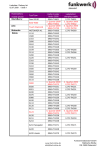
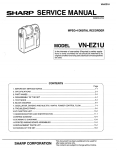

![User Manual ='9 )$ %HQXW]HULQIRUPDWLRQ 2 Ξβεαέγπ Υοάρεπ](http://vs1.manualzilla.com/store/data/006883243_1-bc48910767eff90c10218ead75c6bebd-150x150.png)
